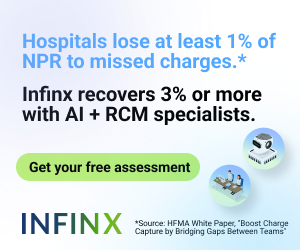Boost charge capture by bridging gaps between teams
How health finance leaders can optimize charge capture and avoid future mishaps
Missed charge capture opportunities cause healthcare organizations to lose millions of dollars. In fact, at the average large hospital, charge capture losses amount to up to up to 1% of annual net revenue at the average large hospital, according to an HFMA article.
To put this in perspective, that’s $5 million for a hospital with $500 million in annual net revenue. There are other downstream consequences too, including denials, delayed payments, and monetary fines for noncompliance.

Yet while healthcare organizations are committed to identifying sources of revenue leakage, they are still struggling with implementing sustainable solutions to prevent charge-capture mishaps in the long term.
Given what’s at stake, healthcare organizations will need to reframe their approach to charge capture — and take a broader, more holistic approach. Healthcare organizations need a charge capture roadmap that incorporates the right technology, processes and full engagement of all departments (e.g., clinical, financial, technology). The right end-to-end strategy will help shift an organization’s focus from simply identifying missed charges to preventing them in the long term.
In this whitepaper, we’ll identify some of the most common underlying issues driving charge capture mishaps — and outline a new path forward optimizing charge capture.
Drilling Down: Understanding the Culprits of Charge Capture Issues
Most health leaders have a good ballpark idea of the most common charge capture mishaps, such as incorrect billing and/or undercoding (e.g., radiology contrast scans that are not billed correctly) or undocumented services (e.g., performing extra billable services during routine checkups, but not documenting them).
However, there is less understanding of why these charge capture mishaps happen, again and again, despite sophisticated automation technology and increased staff training.
Often, the challenge often has less to do with an organization’s technology stack — and more to with its processes and cultural norms, including:

- Clinical staff engagement. In many organizations, clinical teams and revenue cycle teams exist in silos: Clinicians are primarily focused on patient care, often worrying about coding and billing at the end of their shift. “There are silos in every organization, some of them organic, and some are just the result of employees not understanding who the stakeholders are,” said Willie Brown, CRCA, MBA, MT(ASCP), vice president of revenue cycle, Sentara Health. “And so … in a large, complex organization, sometimes those relationships and breaking down silos can be a full-time job.”
- Insufficient IT staff support: Health IT teams are at capacity and have multiple demands on their time. This can mean missed opportunities to build out auditing and charge-editing systems to fit an organization’s needs, according to Brown.
- Gaps in documentation and workflow: Without an expert or a dedicated knowledge base, it’s often challenging to know what the right charge-capture edits are, or how to ensure that workflows are updated to address them, says Brown.
- Unclear ownership: Ownership and accountability are critical to workflow: When something breaks or issues arise, there needs to be a clear chain of command and accountability.
“Organizations need to ask themselves, ‘Who’s going to then be able to take the findings from a charge-capture audit to the department level or to the teams to actually put fixes in place, and make sure that problems are being addressed?’” said Brown.
A Scalable Framework to Optimize Charge Capture
Creating a long-term strategy to address these issues is essential for healthcare organizations to stay profitable, said Brown. Here are the four components of a charge capture framework that focuses on scalable, long-term strategies for charge capture improvement.
1. Identify revenue opportunities and barriers. Invest in EHR and/or automation and reporting tools to check for missing information, flag errors before claims are submitted and isolate negative revenue trends that warrant further investigation. Prioritize charge-capture issues with the highest revenue opportunity, while also considering complexity and internal resources for charge completion.
2. Focus on “invisible” revenue leaks. One of the biggest issues in charge capture is overlooking small, seemingly invisible missed charges that are frequently not documented or trigger an audit. Radiology contrast scans are billable, but often not charged because the way they are documented doesn’t trigger the billing process.
“What’s important is to address them at the source, making sure that you’re finding out where these issues are coming from, the specific department and the specific area or procedures,” said Brown. Moving forward: Look for missed opportunities that would result in the highest possible net yield back to your organization based on your contract.
3. Engage IT, clinical and revenue cycle teams early. Even if they are trained, a lack of clarity over charge capture responsibilities can cause inconsistencies. Tackle the issue from the clinician’s perspective, showcasing strategies that improve charge capture without adding to workload
Consider: Is there a liaison there to be able to explain why things such as automation or charge capture are important to the organization’s overall health? If the answer is “no” or even “maybe,” that’s something an organization may want to consider as it implements a plan to reduce charge capture.

“A lot of times we see the clinical teams are only brought in when there’s an audit issue or a denial,” said Taylor Searfoss, FHFMA, MSPH, Ni2 Hospital Division, Infinx. “But when they’re engaged upfront, when they really understand how documentation impacts financial outcomes, you see greater accountability and better results across the board”
4. Create a structured implementation plan. Once charge-capture-optimization barriers are identified, and healthcare organizations have clinical, financial and IT buy-in for a new charge-capture framework, it’s time to put in place a structured implementation plan, said Brown.
- Focus on bridging silos/collaboration by addressing operational challenges healthcare organizations face when aligning revenue cycle, IT and clinical teams.
- Ensure the right technology updates and automation tools are in place (e.g., make sure EHR charge-capture automation tools, CPT code editors, analytics tools, etc.).
- Assure every department is clear on their respective oversight and accountability for charge capture, remediation and troubleshooting.
5. Monitor, refine and reinforce best practices. Once gaps are identified, it’s time to engage the right teams and implement changes to address those gaps, say Brown and Searfoss. Monitoring, refining and reinforcing best practices becomes more important. Set up a regular, ongoing auditing process, and leverage reporting and analytics tools to glean insights into potential risks or burgeoning charge capture issues. Be sure to engage with compliance and internal audit teams regularly to identify concerns ahead of an audit, said Searfoss.
6. Leverage committees: Sentara Health established an integrity implementation work group made up of executive leadership and revenue-integrity experts, which met a couple of times per month with the organizations’ chartering departments and IT teams. This enabled staff to vet new ideas, tackle projects and brainstorm ideas for future improvements, said Brown.
The group inevitably played a critical role in strengthening charge capture through structured collaboration and rapid implementation of improvements. Some of the key improvements resulting from those sessions include:
- Improved cross-functional engagement (alignment across clinical, IT and revenue teams, and greater shared accountability)
- Faster project execution through timely identification and correction of high-impact charge gaps (e.g., radiology, therapy services) using EHR tools and data analytics
- Sustainable business practices established (e.g., ongoing monitoring, training and escalation processes to ensure long-term program integrity)
- Stronger executive support and leadership buy-in, which elevates charge capture as a strategic priority across the organization
These initiatives drove substantial results, with Sentara reporting a $2.8 million revenue lift within just five months by implementing this structured and collaborative charge capture strategy.
Looking Ahead
While there is no silver bullet to prevent all future charge-capture mishaps, taking a holistic, organization-wide approach to charge capture optimization — through stronger processes, staff buy-in and the utilization of sophisticated technologies — can make a meaningful impact.

Creating or refining new policies around charge reconciliation and charge capture, and obtaining buy-in from clinical, technical and operational leadership, will facilitate smoother communication and issue resolution, according to both Brown and Searfoss.
For organizations that want additional support with boosting their charge-capture opportunities, another option is outsourcing charge capture processes to a third-party expert.
The importance of training and engaging clinical teams cannot be underestimated, as these workers are an organization’s first line of defense to ensure accurate, optimal charge capture.
This starts with understanding that clinicians don’t have 40 to 60 minutes per day to spend on charge capture reconciliation, especially if they’re working on reconciliation at the end of a busy shift. Not only will this cause inaccuracies, but it breeds resentments.
“I’ve seen workflows where someone at a facility expected their nurses to spend 45 minutes at the end of their shift to comb through charges, and that’s typically a 12-hour shift, and that’s not sustainable,” said Taylor Searfoss, FHFMA, MSPH, Ni2 Hospital Division, Infinx.
To improve relationships with clinical teams and better engage with clinicians, Searfoss suggests focusing on the following strategies:
1. Automate manual processes to reduce clinical burden. As much as possible, automate common charge triggers (e.g., procedures, medications, devices used during care that are already documented in the EHR but not automatically linked to billing) and charge reconciliation workflows, especially redundant or duplicative charge-entry processes often placed on nurses or therapists. Note that departments may overlook automation of ancillary services (e.g., blood product administration, radiology contrast) causing these charges to be frequently missed because they rely on manual follow-up or separate documentation systems.
2. Focus on exceptions rather than full charge audits. Instead of reviewing every single charge manually, organizations should use analytics and rules-based engines to flag anomalies, missing charges or outliers. They should also prioritize review of high-risk or high-volume services where errors have historically occurred. For example: Rather than auditing all therapy charges daily, focus on exceptions like missing CPT codes for evaluations or visits with documentation but no charge — patterns that signal breakdowns. Having a tool that can audit 100% of all claims is key for this point. This allows your team to focus on the items that need intervention.
3. Ensure clinical teams see the impact of their contributions. Clinicians are more likely to engage when they see the value of their actions — not just through policy mandates, but through transparent outcomes and positive reinforcement. Be sure to use dashboards or visual reports to demonstrate how accurate documentation translates into financial outcomes and share real examples of recovered revenue tied to proper charting or charge capture corrections. Recognize departments or individuals with measurable improvements.
These strategies reduce friction, foster trust and help clinicians see charge capture as a shared responsibility — not just an administrative burden. When implemented correctly, they lead to better compliance, improved revenue integrity and a more financially resilient organization.
About Infinx
Founded in 2012, Infinx provides scalable, AI-driven solutions that optimize the financial lifecycle of healthcare providers, covering all aspects of patient access and revenue cycle management. Our cloud-based software, powered by advanced automation, is supported by over 6,000 experienced consultants and billing specialists across the U.S., India, and the Philippines. Serving a client base of over 172,000 healthcare professionals across 4,000 facilities—including ambulatory, acute care, and post-acute care providers—we help healthcare organizations capture more revenue, adapt to evolving regulations and payer guidelines, and stay focused on delivering exceptional patient care. For more information, visit www.infinx.com.
This published piece is provided solely for informational purposes. HFMA does not endorse the published material or warrant or guarantee its accuracy. The statements and opinions by participants are those of the participants and not those of HFMA. References to commercial manufacturers, vendors, products, or services that may appear do not constitute endorsements by HFMA.






